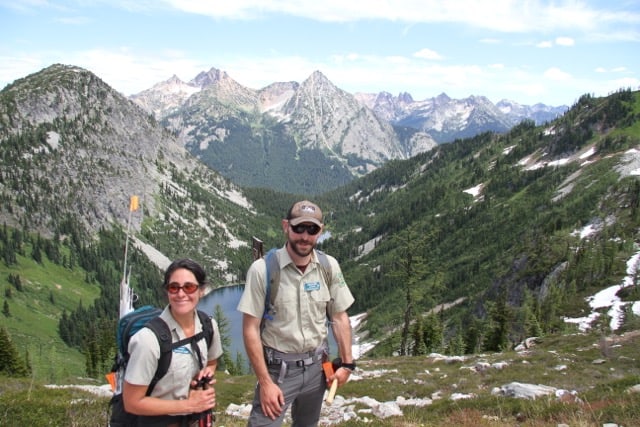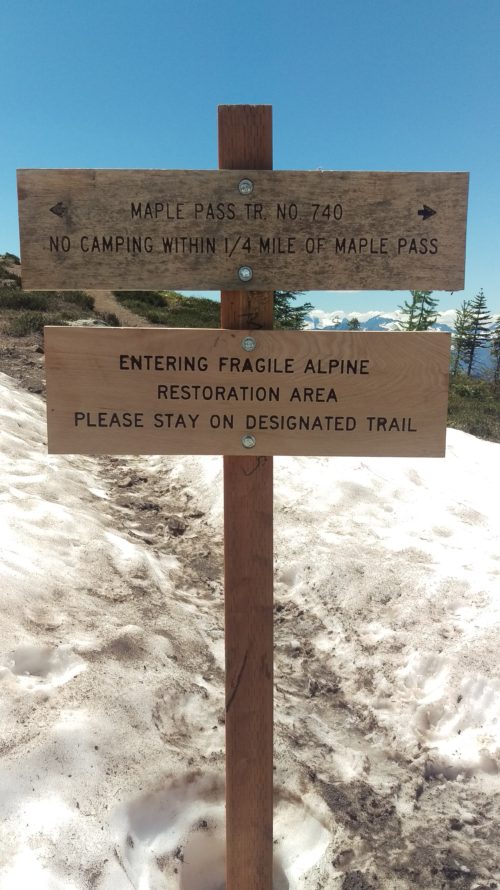
Restoring Our Treasured Landscapes
Written by Master of Education graduate Sasha Savoian
Blue Lake and Maple Pass Loop are two of the most heavily-visited trails off Highway 20 in the North Cascades range, offering access to the unique subalpine ecosystem blanketed in blooming heather in the late summer months.
On the eastern flank of the mountains, the trail to Blue Lake winds through engelmann spruce forest singing with golden crowned kinglets and dark-eyed juncos, into a meadow thick with clustered white valerian, dangling meadow rue, purple lupine, and bell-shaped jacob’s-ladder. It then crests above treeline with spectacular views of Liberty Bell Mountain, Cutthroat Peak and Whistler Mountain toward the northwest. As altitude-loving larch trees appear, pink and white mountain heather pierce the edges of rocks along the trail leading to the aptly-named Blue Lake, where mountain goats are often spotted grazing on subalpine foliage 6,200 feet above sea level, a mere 2.2 miles from the trailhead.

Maple Pass in the North Cascades. Photo by Sasha Savoian
Maple-Heather Pass Loop travels 7 miles from the trailhead and back again through a shady forest of subalpine fir and spruce trees. Pacific wrens sing to an open with talus fields catering to furry hoary marmots and peeking pika. Grey crowned rosy finch and clark’s nutcracker songs slide through larch trees above while hearty heather beckons below, filling gaps between rocks among dotted saxifrage, bugle-shaped penstemon, splayed phlox and deep red indian paintbrush atop 6,600-foot rocky Maple Pass–one of the best views of the North Cascades.
But this dynamic alpine ecosystem is fragile! With their woody stems and short growing season, heather is easily crushed. It takes only 50 booted steps to destroy plants that take upwards of 1,000-5,000 years to establish as a successful colony. Heather plants stabilize soil, prevent wind and water erosion, trap nutrients and control temperature in the soil to promote growth of other alpine vegetation.
Restoration projects on Blue Lake and Maple Pass Loop began in 2012 when the Methow Valley was chosen as one of 14 designated sites as part of the National Forest Foundation’s Treasured Landscapes, Unforgettable Experiences established to connect people and their communities to their forests and watersheds through community engagement and collaboration.
In 2015, with the help of The National Forest Foundation, Methow Natives, the National Park Service and volunteers, 3,500 alpine plants (black sedge, subalpine huckleberry, partridgefoot, and both pink and white heather) were put in the ground at Maple and Heather passes and at Blue Lake in efforts to help restore trampled areas. Restoration areas at both locations were roped off to discourage visitor trampling, social trails were decommissioned and educational signs were installed.

Heather restoration site on Maple Pass. Photo by Sasha Savoian

Restoration site at Maple Pass. Photo by Sasha Savoian

New sign at Maple Pass marking the restoration worksite. Photo by Sasha Savoian
During the summer of 2016, Zachary Lundgren and I — as part of our summer Leadership Tracks with North Cascades Institute’s Graduate Residency program, and with funding from the National Forest Foundation — had the pleasure of maintaining and monitoring these restoration sites by reinforcing roped off areas and educating the public on environmental concerns about public impacts on the area. We informed backpackers of the “no camping policy” and led a group of Upward Bound students to Blue Lake to talk about the importance of restoration. Undoubtedly these restoration sites keep hikers off these fragile areas and revegetation and growth are occurring. We encountered a man that had been hiking Maple Pass Loop for decades and he commented that the area had never looked better!
Written by M.Ed. graduate Sasha Savoian

